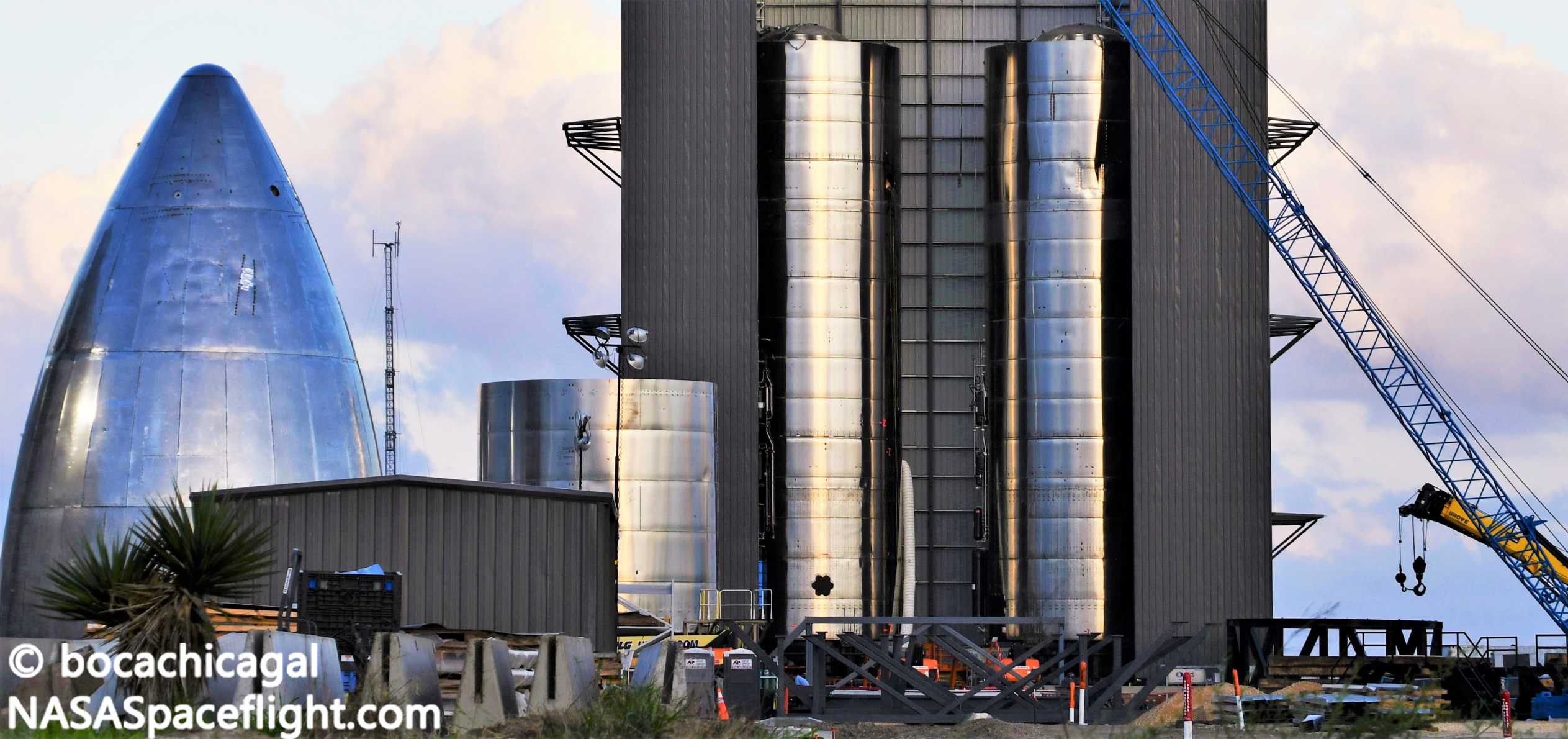
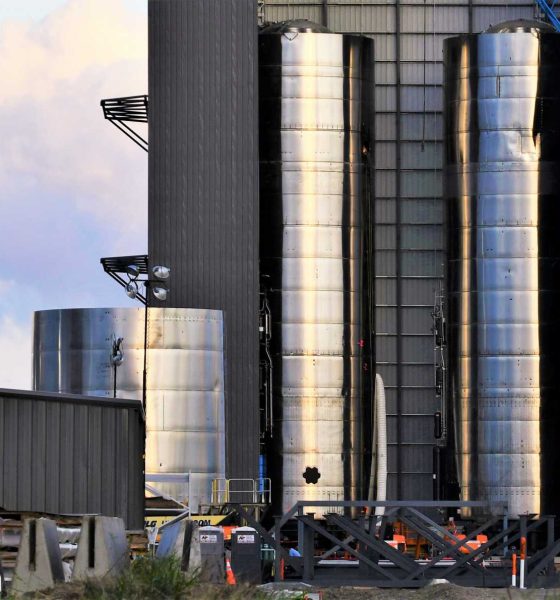
News
SpaceX set to finish three Starship prototypes in the same month
SpaceX appears to be on track to complete its third Starship prototype in a month just days after the company finished testing a new steel tank and at the same time as it prepares to roll another full-scale ship to the launch pad.
Postponed by several weeks after the (fleeting) success of the Starship serial number 4 (SN4) prototype, violently destroyed by a minor testing mishap on May 29th, SpaceX’s fifth full-scale Starship tank section (SN5) could roll to an adjacent testing facility at any point in the next few days. In fact, SN4’s successor has likely been ready to begin tank proof and static fire testing for several weeks since it was stacked to its full height on May 12th. SN4 rolled to the launch pad on April 23rd and remained SpaceX’s top Starship priority until its demise more than a month later.
As it turns out, the explosion that destroyed the ship also launched a ~25 metric ton (~55,000 lb) counterweight installed a few days prior some 100m (300+ ft) into the air, where it proceeded to fall back to earth and obliterate the steel mount Starship SN4 sat on. The loss of that pad hardware necessitated its own several-week delay but SpaceX appears to be nearly done installing and outfitting replacements as of June 18th – an incredible turnaround given the scale and complexity of everything involved. Of course, the whole purpose of those rapid repairs is to get back to the business of testing Starships as quickly as possible.
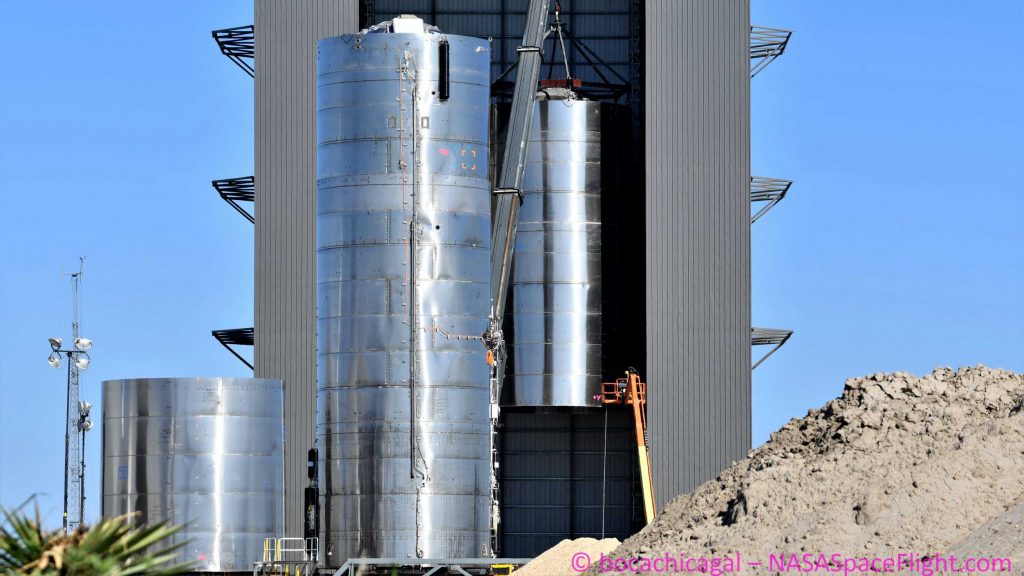
SN5
Initially expected as early as 8am local on June 17th, Starship SN5’s trip to the launch pad has been a long time coming. Completed around May 20th after approximately a month of concerted effort, the ~30m (100 ft) tall tank departed SpaceX’s Vehicle Assembly Building (VAB) for the first on June 13th, although it was quickly moved back inside as technicians simultaneously worked to complete Starship SN6.
Previously scheduled to become the first Starship to reach its full height with the installation of a functional nosecone, SN5 will likely pick up where SN4 left off, instead. That process will effectively be no different, albeit sans nosecone, starting with ambient and cryogenic proof (pressure) tests and eventually moving to one or several static fires with either one or three Raptor engines. Testing the quick disconnect umbilical port that caused SN4’s demise will also likely be a priority. If all goes according to plan in that first week or two of tests, SpaceX may finally be ready to launch a full-scale Starship prototype for the first time, performing a 150m (~500 ft) hop test with SN5.
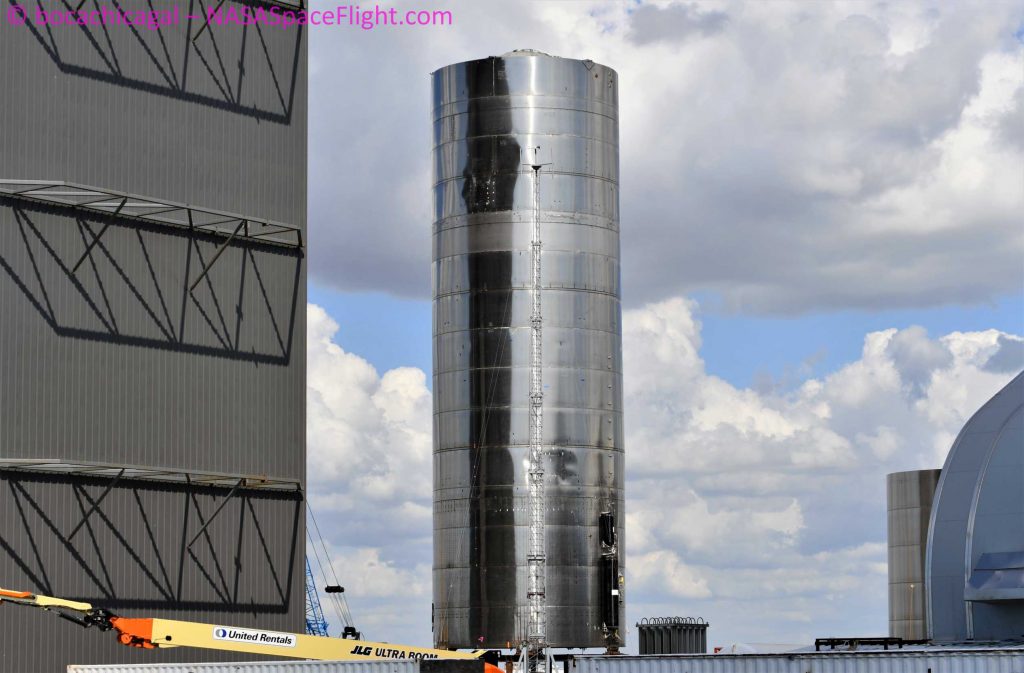
However, since CEO Elon Musk first discussed plans for an initial 150m hop test, SpaceX received a surprise suborbital launch license from the FAA, rather than the limited experimental permit most expected. That license effectively allows SpaceX to perform an unlimited number of Starship tests as long as the trajectory follows the administration’s strict safety guidelines and remains suborbital. Unless SpaceX’s ~150m target was based in some technical limitation, the sky is quite literally the limit for a more ambitious flight debut if the company believes Starship SN5 can handle it.
SN6
In the event that Starship SN5 follows its predecessor into a less early (but still early) grave, SpaceX thankfully won’t have to wait long at all to continue its hardware-rich test program. When Starship SN5 first departed the VAB on June 13th, it did so to give SpaceX room to finish Starship SN6, placing its aft engine section on a stand inside the building and stacking the upper two-thirds of the ship’s tank on top.
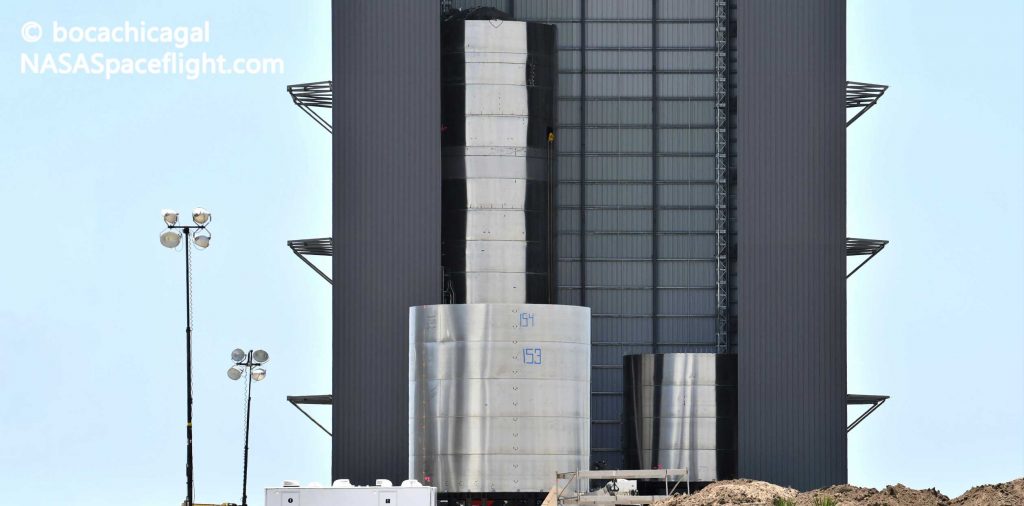
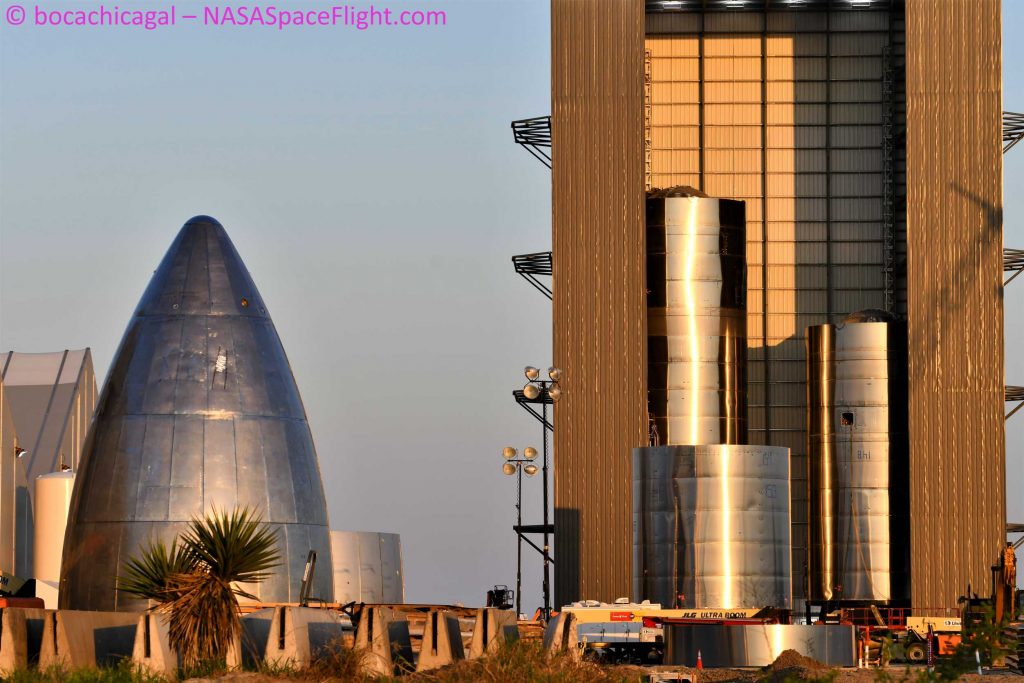
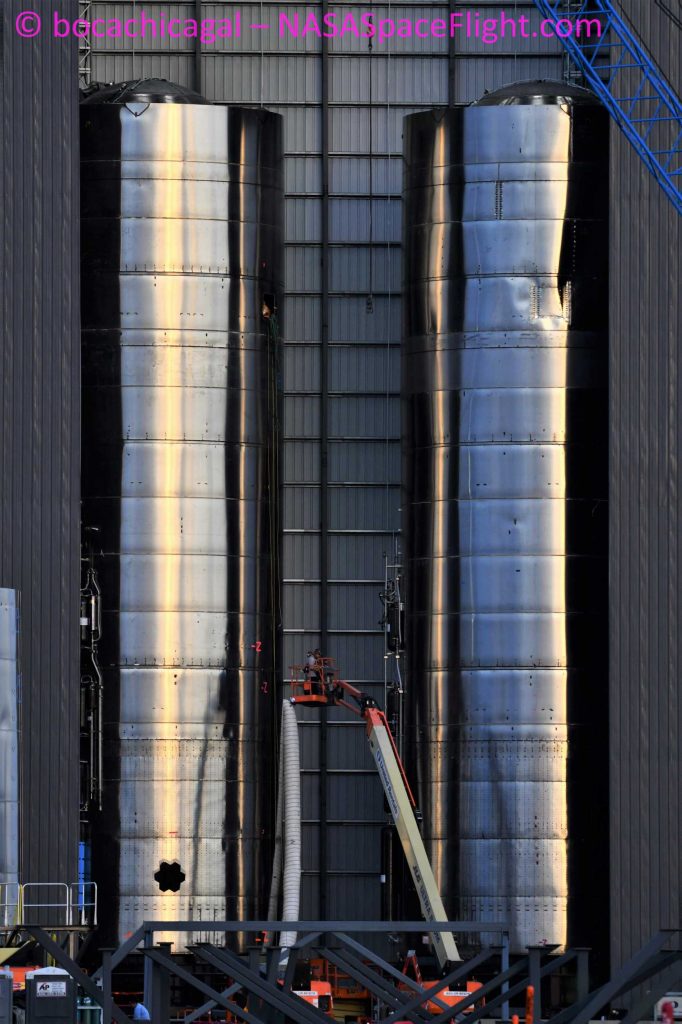
Several days to a week or more of internal and external work remain to fully mate the two Starship SN6 sections, but the vast majority of its assembly is now behind SpaceX. SpaceX continues to refine its methods with each successive prototype, gradually producing Starships that are getting closer and closer to the ideal finished product. There’s a chance that, unlike Starship SN4, SN5 can be modified with the installation of a nosecone and flaps to support more ambitious 2-20 km (~1.2-12 mi) flight tests if it makes it over the 150m hurdle unscathed but if not, SN6 could become the first Starship to have a nosecone installed.
SN7
Last but absolutely not least, SpaceX recently built a new Starship test tank for the first time since March. While stouter than an actual Starship-class methane or oxygen tank, this particular test tank is maybe only 25% shorter than the methane tanks installed on Starship prototypes. According to Musk and effectively confirmed by writing all over the prototype, this particular test tank – formerly Starship SN7 – was built to determine if a different kind of steel could be preferable for future ships.


Shortly after the June 15th test began to wind down, Musk announced that the new material (304L stainless steel) had performed quite well, reaching 7.6 bar (110 psi) before it sprung a leak. The fact alone that it sprung a leak instead of violently depressurizing is already a major sign that 304L is preferable to 301L, as it means that Starships built out of it could fail much more gracefully in the event of a leak instead of collapsing or violently exploding. A step further, SpaceX has already managed to repair the leak on SN7 and will likely test the tank again in the next few days.
Meanwhile, Musk says that a second improved 304L test tank is already on its way, after which SpaceX will likely attempt to build and test the first fully-304L Starship prototype. Further down the line, SpaceX intends to develop its own custom steel alloy, optimized specifically for Starship’s needs. The first tests of that ’30X’ alloy could begin as early as August 2020 according to a February Musk tweet.
Check out Teslarati’s Marketplace! We offer Tesla accessories, including for the Tesla Cybertruck and Tesla Model 3.

News
Tesla China delivery centers look packed as 2025 comes to a close
Needless to say, it appears that Tesla China seems intent on ending 2025 on a strong note.

Tesla’s delivery centers in China seem to be absolutely packed as the final days of 2025 wind down, with photos on social media showing delivery locations being filled wall-to-wall with vehicles waiting for their new owners.
Needless to say, it appears that Tesla China seems intent on ending 2025 on a strong note.
Full delivery center hints at year-end demand surge
A recent image from a Chinese delivery center posted by industry watcher @Tslachan on X revealed rows upon rows of freshly prepared Model Y and Model 3 units, some of which were adorned with red bows and teddy bears. Some customers also seem to be looking over their vehicles with Tesla delivery staff.
The images hint at a strong year-end push to clear inventory and deliver as many vehicles as possible. Interestingly enough, several Model Y L vehicles could be seen in the photos, hinting at the demand for the extended wheelbase-six seat variant of the best-selling all-electric crossover.
Strong demand in China
Consumer demand for the Model Y and Model 3 in China seems to be quite notable. This could be inferred from the estimated delivery dates for the Model 3 and Model Y, which have been extended to February 2026 for several variants. Apart from this, the Model Y and Model 3 also continue to rank well in China’s premium EV segment.
From January to November alone, the Model Y took China’s number one spot in the RMB 200,000-RMB 300,000 segment for electric vehicles, selling 359,463 units. The Model 3 sedan took third place, selling 172,392. This is quite impressive considering that both the Model Y and Model 3 are still priced at a premium compared to some of their rivals, such as the Xiaomi SU7 and YU7.
With delivery centers in December being quite busy, it does seem like Tesla China will end the year on a strong note once more.
News
Tesla Giga Berlin draws “red line” over IG Metall union’s 35-hour week demands
Factory manager André Thierig has drawn a “red line” against reducing Giga Berlin’s workweek to 35 hours, while highlighting that Tesla has actually increased its workers’ salaries more substantially than other carmakers in the country.

Tesla Giga Berlin has found itself in a new labor dispute in Germany, where union IG Metall is pushing for adoption of a collective agreement to boost wages and implement changes, such as a 35-hour workweek.
In a comment, Giga Berlin manager André Thierig drew a “red line” against reducing Giga Berlin’s workweek to 35 hours, while highlighting that Tesla has actually increased its workers’ salaries more substantially than other carmakers in the country.
Tesla factory manager’s “red line”
Tesla Germany is expected to hold a works council election in 2026, which André Thierig considers very important. As per the Giga Berlin plant manager, Giga Berlin’s plant expansion plans might be put on hold if the election favors the union. He also spoke against some of the changes that IG Metall is seeking to implement in the factory, like a 35-hour week, as noted in an rbb24 report.
“The discussion about a 35-hour week is a red line for me. We will not cross it,” Theirig said.
“(The election) will determine whether we can continue our successful path in the future in an independent, flexible, and unbureaucratic manner. Personally, I cannot imagine that the decision-makers in the USA will continue to push ahead with the factory expansion if the election results favor IG Metall.”
Giga Berlin’s wage increase
IG Metall district manager Jan Otto told the German news agency DPA that without a collective agreement, Tesla’s wages remain significantly below levels at other German car factories. He noted the company excuses this by referencing its lowest pay grade, but added: “The two lowest pay grades are not even used in car factories.”
In response, Tesla noted that it has raised the wages of Gigafactory Berlin’s workers more than their German competitors. Thierig noted that with a collective agreement, Giga Berlin’s workers would have seen a 2% wage increase this year. But thanks to Tesla not being unionized, Gigafactory Berlin workers were able to receive a 4% increase, as noted in a CarUp report.
“There was a wage increase of 2% this year in the current collective agreement. Because we are in a different economic situation than the industry as a whole, we were able to double the wages – by 4%. Since production started, this corresponds to a wage increase of more than 25% in less than four years,” Thierig stated.
News
Tesla is seeing a lot of momentum from young Koreans in their 20s-30s: report
From January to November, young buyers purchased over 21,000 Teslas, putting it far ahead of fellow imported rivals like BMW and Mercedes-Benz.

Tesla has captured the hearts of South Korea’s 20s-30s demographic, emerging as the group’s top-selling imported car brand in 2025. From January to November, young buyers purchased over 21,000 Teslas, putting it far ahead of fellow imported rivals like BMW and Mercedes-Benz.
Industry experts cited by The Economist attributed this “Tesla frenzy” to fandom culture, where buyers prioritize the brand over traditional car attributes, similar to snapping up the latest iPhone.
Model Y dominates among young buyers
Data from the Korea Imported Automobile Association showed that Tesla sold 21,757 vehicles to the 20s-30s demographic through November, compared to BMW’s 13,666 and Mercedes-Benz’s 6,983. The Model Y led the list overwhelmingly, with variants like the standard and Long Range models topping purchases for both young men and women.
Young men bought around 16,000 Teslas, mostly Model Y (over 15,000 units), followed by Model 3. Young women followed a similar pattern, favoring Model Y (3,888 units) and Model 3 (1,083 units). The Cybertruck saw minimal sales in this group.
The Model Y’s appeal lies in its family-friendly SUV design, 400-500 km range, quick acceleration, and spacious cargo, which is ideal for commuting and leisure. The Model 3, on the other hand, serves as an accessible entry point with lower pricing, which is valuable considering the country’s EV subsidies.
The Tesla boom
Experts described Tesla’s popularity as “fandom culture,” where young buyers embrace the brand despite criticisms from skeptics. Professor Lee Ho-geun called Tesla a “typical early adopter brand,” comparing purchases to iPhones.
Professor Kim Pil-soo noted that young people view Tesla more as a gadget than a car, and they are likely drawn by marketing, subsidies, and perceived value. They also tend to overlook news of numerous recalls, which are mostly over-the-air software updates, and controversies tied to the company.
Tesla’s position as Korea’s top import for 2025 seems secured. As noted by the publication, Tesla’s December sales figures have not been reported yet, but market analysts have suggested that Tesla has all but secured the top spot among the country’s imported cars this year.








